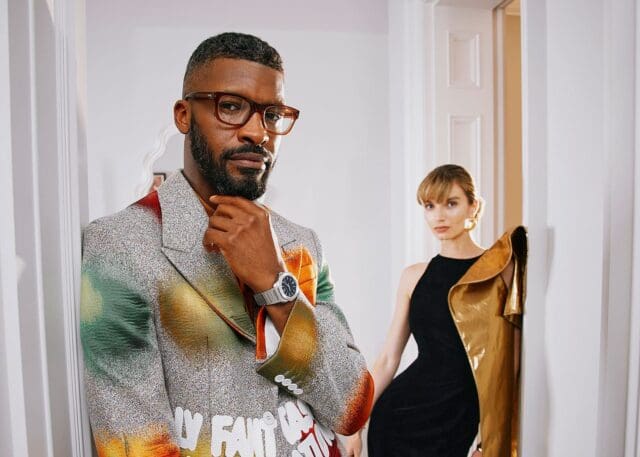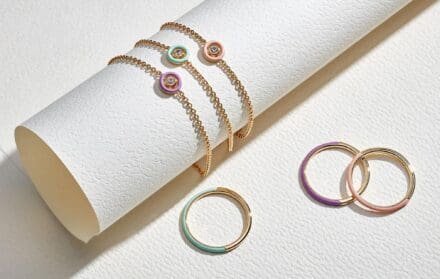
Jenny Packham: The British designer on Bond girls, Harry Styles and always dressing for yourself
She's outfitted the Duchess of Cambridge, Angelina Jolie and Taylor Swift. As she publishes her new book, How To Make A Dress, we catch up with Jenny Packham
For someone who has spent the past 10 years rubbing shoulders with A-list celebrities and dealing with the “maelstrom of egos” that comes with it, Jenny Packham is surprisingly reserved. She has a clipped accent and a countenance that doesn’t give much away. And then she’ll talk about nipple pasties, or confess her love for Harry Styles, and you feel silly for ever thinking her austere.
I meet the fashion designer in her North London studio, a white-washed warehouse where puffs of gauze and clouds of lace emanate from boxes and clothes rails everywhere. Her sprocker, Byron, darts between them. It took “over a decade of sartorial social climbing” to get here, Packham has said. She started her business with her now-husband, Mathew Anderson, after graduating from Central Saint Martins in 1987. “We were dressing UK pop stars and TV personalities, and I got to the point where I was very frustrated because I wanted to be dressing A-stars,” she recalls. “So we had to recalibrate. For two years we stopped dressing people that we didn’t think we should dress – it’s so awkward saying that! – but you have to.”
The gamble paid off. In 2011, Sandra Bullock wore a powder-pink Jenny Packham dress to the Golden Globe Awards, and the course was set. Now, if you follow celebrity culture in any way, you will have seen Packham’s designs, even if you didn’t know it. Perhaps on the Duchess of Cambridge, who is a long-time fan. That gilded number she wore to the premiere of No Time to Die? Packham. The emerald gown at 2021’s Royal Variety Show? Packham. The midis she wore to leave the hospital after giving birth to her children? All Jenny Packham. She’s also dressed Adele, Angelina Jolie, Miley Cyrus, Keira Knightley, Taylor Swift, Kate Hudson, Blake Lively, Emily Blunt, Dakota Fanning… You get the picture. Packham also created one of Elizabeth Hurley’s 13 wedding dresses (because Lord knows one isn’t enough) for her nuptials to businessman Arun Nayar in India – bridalwear makes up about 30 per cent of the brand’s revenue.

“We have a nice spectrum,” says Packham. “We like dressing people when they’re on the way up, like Millie Bobby Brown when she was, like, 14.” This goes all the way up to industry veterans like Dame Helen Mirren. “One of my favourite challenges was when we had four days to make a dress for Kate Winslet. It was 20 years on from the premiere [of Titanic], and she’d transformed from this new actress into an icon, and we wanted to reflect that.”
The variety of Packham’s clientele reflects a universality to her designs. Her signature gowns and cocktail dresses are all underpinned by an adherence to time-honoured, flattering silhouettes. They are also beautiful; the Jenny Packham provenance means twinkling sequins, cascading beadwork, and scores of chiffon. Her pieces are Regency Glamour meets Old Hollywood meets Fairy Princess rolled in glitter and finished with a bow.
“That’s the fun part for me each season. It’s like, ‘what should I be inspired by’?” she says. For her SS15 collection, Packham’s muse was Marilyn Monroe. The designer dug out all of the memorabilia she could get her hands on, even meeting a man who had a collection of Monroe’s old dresses under his bed (actually, it was Queen Victoria’s childhood bed, but that’s a different story). “It was amazing, but at the same time I knew it was all wrong – he’s got these dresses just folded up in boxes and they’re, like, priceless.”
 |  |
“The inside of them was far more interesting than the outside,” Packham recalls. “There was all this tape they used to hold everything in. It was almost as though, on the outside, she was all sparkly and wonderful, but on the inside there were all these restrictions and buttons and pulleys propping her up.”
Packham’s designs aren’t just for the red carpet; they’ve also made it on screen. The label had a cameo in Gossip Girl, and she worked with Patricia Field on Sex and the City. Packham also dressed Rosamund Pike in Die Another Day and Caterina Murino in Casino Royale. For the 60th anniversary of James Bond, she was approached by Eon to collaborate on a collection.
Bond girls, what they represent, and specifically what they wear, have become a contentious issue in recent times (indeed, while going through the film archives, Packham was struck by the lack of dresses, compared to the abundance of skimpy bikinis), so I’m keen to get her perspective on dressing the female stars of the films: “The Eon team is very conscious of making sure that Bond comes up to date, without losing everything that he’s about. But I also think we have to live with history.”
It is, Packham also points out, a question of empowerment versus objectification. “Just look at the industry now, and what Beyoncé and Rihanna and everybody wears,” she says. “But there’s a new interpretation of it now. It’s about what the woman wants.” Packham has a long-standing relationship with burlesque artist Dita Von Teese, who she feels embodies this new brand of ‘sexy’: “She’s completely in control of what she is giving to you, even though she gives quite a lot.”

“I dress for myself, and I think that most women would say the same. I don’t think we dress for men,” Packham continues. Case in point: her wedding dress, which was clearly a labour of love. “I indulged myself in buying some really expensive lace and hand-stitched it,” she recalls. “I love the dress. I love wearing it.” Packham paired her creation with a veiled headband which, she says, had the added benefit of shielding her from people’s stares. Indeed, an aversion to “people looking at [her]” was, apparently, part of the reason that she didn’t marry her partner until they’d been together for 28 years.
For a designer who must have dressed 10 Oscar categories’ worth of stars, Packham herself shies away from the limelight. She doesn’t buy into wacky collaborations (the partnership with the 007 franchise was very much on her terms) or influencer marketing to raise her profile. Instead, Packham sticks to what she knows. “If women want to look quirky or experimental, they go elsewhere,” she has said. “I’m not in the business of making anyone seem avant-garde.”
It is this simple objective that inspired the rather succinct title of Packham’s new book, How to Make a Dress. In it, among other things, she asks what makes a perfect garment: “It’s when everything comes together – the cut, the colour, the fit. It’s new, but it’s got something about it that people recognise.”
 |  |
‘Perfection’, or at least a sort of glossy aestheticism, seems to characterise Packham’s life. Her world is full of beautiful places and things, as though curated by her favourite photographer, Cecil Beaton. She’ll be sipping a glass of wine in New York’s Cafe Gitane one day, and checking into the stunning The Imperial hotel in Delhi (the location of her factories) the next. At home, Packham can be found perusing the latest exhibition at the Royal Academy, ambling in the Wiltshire countryside or dining at J Sheekey, Covent Garden’s elegant red-fronted fish restaurant.
But Packham is also warm, funny and messy. She writes rambling, prosaic captions on her personal Instagram, and doesn’t mind making fun of herself, admitting to a “fixation” with Harry Styles (“just the way he looks and dances – I love people who’ve got that charisma”). She’s not actually “sure [she’s] ever made a perfect dress”, and her favourite-ever garment is not one of her lofty creations, but a now-falling-apart Donna Karan jacket bought for her by her mum 20 years ago.
All of which leads me to wonder whether perfection is overrated; whether – like the tape inside Monroe’s garments – it’s the imperfections that actually make life interesting. As Packham’s book explores, beautiful clothes are a façade; it’s the stuff inside that matters. That said, if you are going to present a front to the world, you may as well make it a fabulous frock dripping in crystals.
Read more: In conversation with Dsquared2’s Dean and Dan Caten









